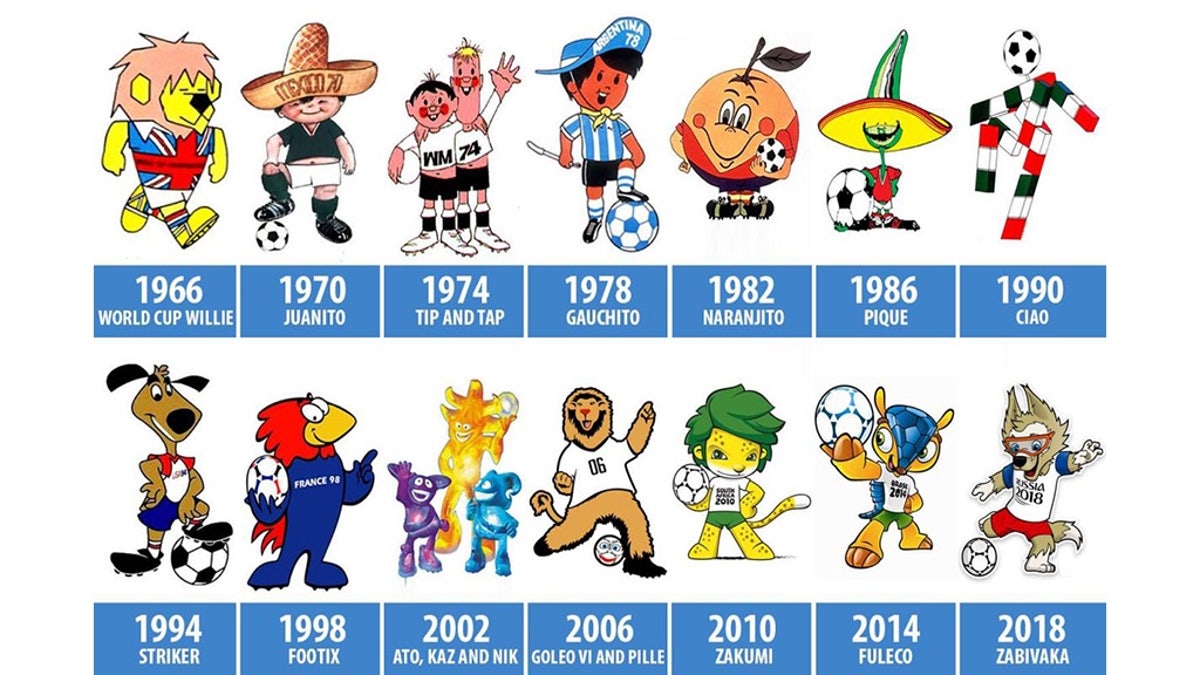
World Cup mascots have varied over the years. (FIFA)
Have you met "the one who scores"?
That's Zabivaka, a wolf who is the mascot for the 2018 FIFA World Cup. The animal's name is said to mean “the one who scores.”
As part of his look, the soccer-playing animal sports goggles.
“He has taken to wearing cool sports glasses when he’s in action; he believes they give him special targeting powers on the pitch,” FIFA claims.
2018 FIFA WORLD CUP: WATCH LIVE MATCHES STREAMING ON FOX SPORTS FROM JUNE 14 TO JULY 15
The furry creature is part of a long line of mascots that date back to 1966. Read on to see famous figures from the past.
World Cup Willie, 1966
"I am Willie, hear me roar!" This lion was the mascot for the international soccer tournament held in England.
“With his union flag football shirt and ‘60s mop-top mane, ‘World Cup Willie’ was a high-profile presence throughout England 1966, becoming popular with fans both young and old,” FIFA says online.
Juanito, 1970
Meet Juanito, who symbolized the 1970 World Cup in Mexico. An illustration shows him in a sombrero while standing with one foot on top of a soccer ball.
Tip and Tap, 1974
Was it double the fun? Tip and Tap were the mascots when the World Cup took place in West Germany.
The mascots were made in order to promote harmony between East and West Germany, the teams drawn to compete against each other during the group stage, ESPN reports.
Gauchito, 1978
A youngster named Gauchito was the mascot for the 1978 World Cup in Argentina. Fox Sports reports that his hat, whip and bandanna “were typical gaucho attire.”
Naranjito, 1982
Orange you glad I’m here? The 1982 World Cup was represented by Naranjito the orange.
The fruit reportedly had a special significance, as it was aimed at symbolizing optimism after Spain emerged from General Franco's dictatorship, ESPN reports.
Pique, 1986
A pepper in a sombrero was the mascot for the World Cup in Mexico.
The character earlier drew scrutiny in 1984: a New York Times article at the time said that the character was criticized by Mexican nationalists and, accordingly, was the target for a series of jokes.
Ciao, 1990
This faceless figure was the mascot when Italy hosted the World Cup.
Its name, “Ciao,” also means “hello” and “goodbye” in Italian.
Striker the World Cup Pup, 1994
Warner Brothers reportedly created the canine for the 1994 tournament held in the United States.
Footix, 1998
This cockerel was France's World Cup mascot.
His daughter, a chicken named ettie, will be the mascot for the 2019 Women’s World Cup, which will take place in the European country.
“Footix cast his star far into the night sky so it could shine brightly, and after a few years of travelling through the cosmos it came back to him in the form of his twinkling daughter, ettie,” FIFA said in a post online.
Ato, Kaz and Nik, 2002
The World Cup in Korea and Japan had three mascots, Ato, Nik and Kaz, who formed “The Spheriks.”
“Orange, purple and blue, these animated creations participated in ‘Atomball’, a fictional football-like sport, with Ato the coach and Kaz and Nik his players,” FIFA said.
GOLEO VI, 2006
The pantsless lion was the mascot when Germany hosted the World Cup in 2006 - and also had a friend.
“GOLEO VI’s constant companion, Pille the talking football, is always at his side,” FIFA said in a release. “They are an unequal double-act, as Pille is a right chatterbox who wears his heart on his sleeve.”
Zakumi, 2010
Another big cat, Zakumi the leopard, was chosen as the mascot for the 2010 World Cup in South Africa.
FIFA explained the feline’s name in a release.
“The name is a composition of 'ZA,' standing for South Africa, and 'kumi' translating into '10' in various languages across Africa,” the statement read.
Fuleco, 2014
The mascot for the 2014 World Cup in Brazil was Fuleco, the three-banded Brazilian armadillo.
“Futbol” and “ecologia” are combined for the character's name, according to FIFA.
“The shell that protects him has evolved to represent the natural beauty of Brazil that he is so committed to protecting,” the organization said.